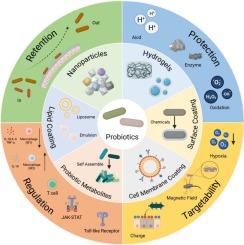控制肠道输送和微生物群失调治疗的益生菌包封策略
IF 11.5
1区 医学
Q1 CHEMISTRY, MULTIDISCIPLINARY
引用次数: 0
摘要
益生菌因其在促进肠道健康方面的多样化和重要作用而引起了人们的极大兴趣。然而,一些挑战仍然阻碍着它们的临床疗效,包括口服给药期间生物活性的保持、肠道病变的有效靶向、肠道微环境的调节以及定殖时间的延长。本文综述了基于生物材料的肠道靶向益生菌包封策略的全面概述。特别关注的因素是控制益生菌菌株的选择和微生物相互作用在塑造口腔给药系统的设计中的作用。此外,我们强调了与口服递送相关的关键挑战,总结了功能材料及其潜在机制,并对其优势和局限性进行了比较分析。详细探讨了影响益生菌菌种选择和包封方法的关键因素。该综述还强调了主要的胃肠道障碍,如可变pH值、消化酶、活性氧(ROS)、定植抗性、快速运输时间和黏液层降解,并概述了相应的缓解策略。本文讨论了包封益生菌在靶向递送系统和免疫调节方面的最新进展,并对目前的治疗应用进行了调查。最后,探讨了该领域的新趋势和面临的挑战,强调了封装益生菌系统在恢复微生物群稳态和治疗生态失调相关疾病方面的巨大潜力。本文章由计算机程序翻译,如有差异,请以英文原文为准。


Probiotic encapsulation strategies for controlled intestinal delivery and microbiome dysbiosis therapy
Probiotics have garnered significant interest due to their diverse and vital roles in promoting intestinal health. However, several challenges continue to impede their clinical efficacy, including the preservation of bioactivity during oral administration, effective targeting of intestinal lesions, modulation of the gut microenvironment, and extension of colonization time. This review offers a comprehensive overview of biomaterial-based encapsulation strategies for targeted probiotic delivery to the intestine. Particular attention is given to the factors that govern the selection of probiotic strains and to the role of microbial interactions in shaping the design of oral delivery systems. Furthermore, we highlight the critical challenges associated with oral delivery, summarize the functional materials and their underlying mechanisms, and provide a comparative analysis of their strengths and limitations. Key factors influencing probiotic strain selection and encapsulation methods are examined in detail. The review also highlights major gastrointestinal barriers—such as variable pH, digestive enzymes, reactive oxygen species (ROS), colonization resistance, rapid transit time, and mucus layer degradation—and outlines corresponding mitigation strategies. Recent progress in targeted delivery systems and immune modulation enabled by encapsulated probiotics is discussed, along with a survey of current therapeutic applications. Finally, emerging trends and ongoing challenges in the field are explored, emphasizing the promising potential of encapsulated probiotic systems in restoring microbiome homeostasis and treating dysbiosis-related disorders.
求助全文
通过发布文献求助,成功后即可免费获取论文全文。
去求助
来源期刊

Journal of Controlled Release
医学-化学综合
CiteScore
18.50
自引率
5.60%
发文量
700
审稿时长
39 days
期刊介绍:
The Journal of Controlled Release (JCR) proudly serves as the Official Journal of the Controlled Release Society and the Japan Society of Drug Delivery System.
Dedicated to the broad field of delivery science and technology, JCR publishes high-quality research articles covering drug delivery systems and all facets of formulations. This includes the physicochemical and biological properties of drugs, design and characterization of dosage forms, release mechanisms, in vivo testing, and formulation research and development across pharmaceutical, diagnostic, agricultural, environmental, cosmetic, and food industries.
Priority is given to manuscripts that contribute to the fundamental understanding of principles or demonstrate the advantages of novel technologies in terms of safety and efficacy over current clinical standards. JCR strives to be a leading platform for advancements in delivery science and technology.
 求助内容:
求助内容: 应助结果提醒方式:
应助结果提醒方式:


